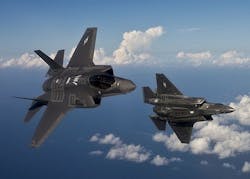F-35 combat jet: only time will tell if current problems will become long-term deficiencies
Couple this with the F-35's estimated dizzying $1.3 trillion program cost, and the news sounds bad ... really bad.
Nevertheless, I would urge patience for those seeking to condemn the F-35 program. I'm not saying that the aircraft's stated problems are not real, and not serious, but I remember a big and expensive military aircraft program 35 years ago that unfolded in a remarkably similar way, and ended up being a tremendously successful program.
It was the Boeing (then-McDonnell Douglas) F/A-18 Hornet strike fighter -- a carrier-based jet fighter-bomber for the U.S. Navy and Marine Corps. The Hornet was developed to replace Navy and Marine Corps carrier-based F-4J Phantom II jet fighters and A-7E Corsair II light-attack bombers, as well as the A-6E Intruder heavy bombers.
Related: The F-35 joint strike fighter's turbulent march to combat readiness
I was a cub reporter in 1981 covering Lemoore Naval Air Station for a small Central California daily newspaper. At that time the Navy had one operational F/A-18 -- the lead plane for the first Hornet training squadron, VFA-125. The F/A-18 had yet to be deployed, still was being developed, and was a absolute wonder for the Navy pilots who had an opportunity to fly it.
story continues below
"What a machine!" I heard a Navy fighter pilot shout one day as he climbed down from an early-model F/A-18 after flying it for the first time. Those Navy pilots at Lemoore loved the Hornet because it was fast -- Mach 1.8 with throttles to the wall -- and it could fly straight up -- something their 1960s-vintage A-7Es couldn't do.
Around that time, however, the Hornet jet was under heavy fire in the press and from congressional opponents who, rightfully, were pointing out the plane's shortcomings.
Critics of the F/A-18 said the plane at an estimated $24.5 million per copy, were far too expensive, had poor radar lock-on capability, failed to meet Navy-established performance standards, and had a relatively short range, which threatened to crimp Navy attack capability and force aircraft carriers to operate dangerously close to shore.
Related: Joint Strike Fighter ushers in a new generation of avionics subsystems and technology
Compounding the Hornet's short combat radius was its then-inability to function as a mid-air refueling tanker -- a role that the A-7Es and A-6Es the Hornet was replacing were able to carry out routinely. The Hornet's short range and inability to refuel other aircraft would compromise the Navy's ability to project power from the sea, critics said.
story continues below
Early models of the Hornet also were unable to carry the Harpoon anti-ship missile, as the A-6E bomber could, which compromised the Navy's ability to attack enemy warships at sea, critics claimed.
Fast-forward now from 1981 to 2016. The F/A-18 is one of the most successful combat aircraft programs ever. In addition to the U.S., the plane has flown with military forces from Australia, Canada, Finland, Kuwait, Malaysia, Spain, Switzerland.
In the U.S. alone the plane has flown with 65 Navy and Marine Corps squadrons. Since 1986 the Hornet has flown combat missions from Libya, to Iraq, to Yugoslavia, including Operation Desert Storm, Operation Southern Watch, and Operation Iraqi Freedom.
Related: FL Technics: F-35 not prepared to run the show despite being officially ‘ready’
The F/A-18 is a mainstay at air shows around the world to this day, and is the chosen aircraft for the Navy Blue Angels flight demonstration team.
When the Navy's air-power needs changed, so did the F/A-18. The F/A-18C and D models got new avionics, more powerful radar, and the ability to carry the Harpoon missile, as well as other munitions. When the Navy needed a bigger fighter-bomber, Boeing stretched the Hornet's fuselage, gave it bigger wings, and called it the F/A-18E/F.
This is not to soft-pedal the F-35's stated problems; they're serious and real. In 10 years, however, I wonder if we'll still be talking about the new plane's shortcomings, or if we'll consider it one of the most formidable combat jets in the world.
